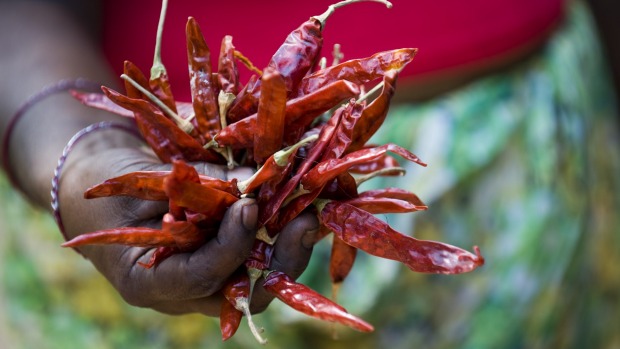
After a lifetime of putting (almost) everything in my mouth – dog, toad, rotten fish and cheese so old it qualifies for the pension – Sri Lanka, the game is on.
Let's not muck around, let's go straight to the source: Sri-Lankan born chef Peter Kuruvita is Australia's go-to man for everything edible on the Tasmania-sized island.
Kuruvita's top suggestion is also possibly Sri Lanka's top restaurant, the officious-sounding Ministry of Crab (Old Dutch Hospital, Colombo). It was always going to be a hit with the locals: in cricket-mad Lanka, the restaurant is owned by test cricketers Mahela Jayawardene and Kumar Sangakkara, along with chef Dharshan Munidasa, Sri Lanka's answer to Our Tetsuya. The half-Sri Lankan, half-Japanese celebrity chef is also owner of the polished benchmark of Japanese cuisine, Nihonbashi (1 Galle Face Tce, Colombo).
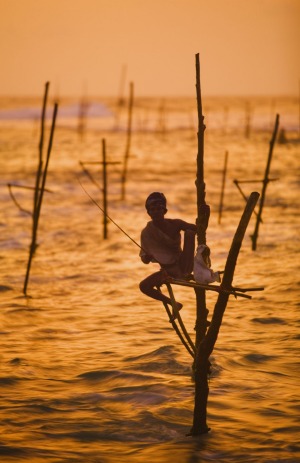
Ministry is set in the Old Dutch Hospital complex, which should be the first stop on the first-time tourist's list for its excellent cafe and shopping scene, a hit with locals and out-of-towners alike.
Thank goodness Kuruvita advises me to book ahead. Midweek, and Ministry is pumping on the signature cocktail, Small Island iced tea, made with Sri Lankan tea and Old Arrack, a traditional spirit made from the sap of coconut palm flowers. The signature dish, chilli crab, comes out in a flurry of waiter's whites and torturous cutlery while the open kitchen rattles and howls, with the occasional spurt of naked flame.
Driving around the island, fruit stands offer an unashamed abundance including Sri Lanka's 18 types of banana.
"I went to Singapore and I ate their chilli crab," chef Dharshan tells me. "But Singapore has no crab, no chilli and no pepper. It's all from Sri Lanka. So why do they think they own it?"
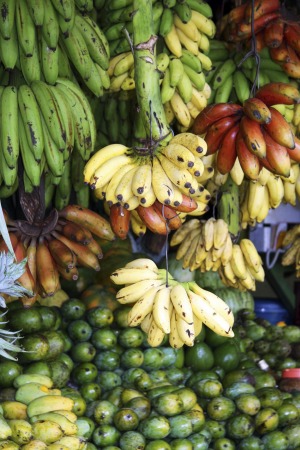
He's a man on a mission to prove Sri Lanka has its own cuisine. "We're not sitting in a rice paddy, smashing spices with rocks," he says. "We're as sophisticated as anyone else."
Regardless, if you asked any traveller for their take on the local food, the first thing that comes to mind is also its most humble.
It's the hopper. A hand-sized crepe made with rice flour and coconut milk and cooked in a cupped pan, we're not talking haute cuisine here. String hoppers are made with rice noodles that, despite all the gaps, are ideal for soaking up curry sauces. Early in the morning, hopper stands line the roadsides and laneways: little carts that fuel a nation for the day ahead.
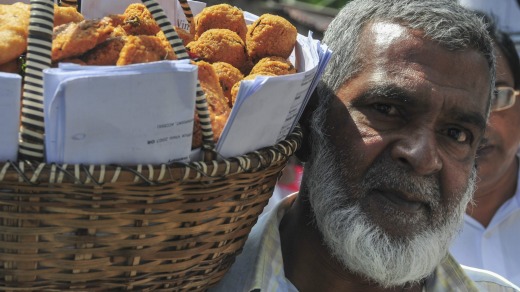
"Ask for an egg hopper and seeni sambal," Kuruvita has recommended.
The first place I taste hoppers probably isn't where Kuruvita had in mind. Forget street sellers, I'm in Galle's top digs, the Amangalla hotel. Specifically, I'm in the pool and breakfast is being delivered to my poolside ambalamba (cabana) early one fine morning. Three hoppers are beautifully presented on china, an egg baked into the well of the fine crepe.
There's a pot of bright Sri Lankan tea and an array of condiments including seeni sambal – a sweet onion and chilli relish – and pol sambal, which Ministry chef Dharshan names his quintessential Sri Lankan dish.
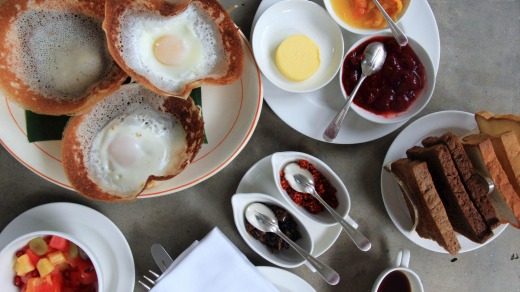
"Pol sambal's not the most expensive, it's not the most interesting, but it's the most important on the table," he says.
Pol sambal is a dish of fresh grated coconut (pol means coconut in Sinhalese) spiced with lime, red onion, cured tuna flakes and a blistering amount of fresh chilli. The locals ladle chilli onto hoppers for a morning eye-opener, at lunch as a pick-me-up then at dinner, as a tasty side to round out their chilli intake for the day.
In between, Sri Lankans are incorrigible snackers. If you find yourself in someone's house at 3.30pm, chances are you're in time for tea and butter cake, a super-simple Madeira-style cake that kicks the country over the afternoon slump.
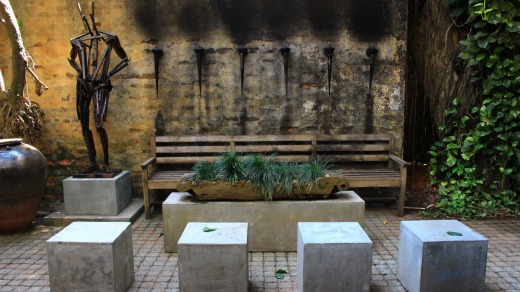
Otherwise, they're queuing at their favourite short-eats stand. Short eats are not for the weight conscious: savoury little calorie bombs such as deep-fried fish rolls, sausage pastries, creamy chicken pastries or spicy vege samosa. There's fierce competition as to the best short-eats shop on this island, the epi-centre appearing to be in the Colombo 3 district, home to old-timer The Fab (474 Galle Rd), upmarket contender Sponge (347 Galle Rd) and the undying institution that is Green Cabin (453 Galle Rd).
If you're leery of eating on the street, follow the trail of foreigners to one of the many, many branches of the 100-year-old Perera & Sons, who've lifted the game with sparkling shops and, let's be practical, nice loos . Trucking kids with you? While you're in there, make like a local and grab a pack of rulang cookies, crunchy semolina and coconut biscuits spiced with cumin seeds as a good travel snack.
In this neighbourhood, travelling and eating are indistinguishable: at the Hatton train station, up in the tea-growing district, men lift baskets of steaming wadi, fried savoury snacks with chilli chutney, up to my window, hot, deep fried lentil patties wrapped in the leaves of a child's old schoolbook, soaking up the tasty oils.
On the drive from Galle to Yala National Park, we stop to photograph the famed stilt fishermen of Tangalle Lake, where a retired fisherman sells us king coconuts. He slices the top off with a machete and we sit beneath a shade of woven leaves, drinking fresh coconut water while his sons teeter on poles, one eye on the fish, one eye on our coin.
In Tangalle, at the insanely luxurious Amanwella hotel, I dine on seafood caught by local fishermen that morning. Move over, deep-fried seafood basket, this is the real deal: prawns, mahi mahi, red mullet, seer fish (Spanish mackerel) and calamari are served with steamed rice, mango and papaya salad and gotukola salad.
"Gotukola makes you look younger and helps you lose weight," the waiter tells me helpfully. Bring me two, please. So great are its claims, gotukola is known for its miracle properties in the West and is also in Ayurvedic medicine, so I joyfully wolf down the salad, which looks like chopped spinach, dressed with the omnipresent chilli, coconut and fresh lime juice.
Driving around the island, fruit stands offer an unashamed abundance including Sri Lanka's 18 types of banana, and tiny villages on the highways sell just one food, be it Kadjugama (literally 'cashew village') on the Colombo-Kandy road, Thihariya for mandarins the colour of a Buddhist monk's robes or buffalo curd (meekiri), served roadside in Andalla, deep in the Southern Province, drizzled with kitul syrup, or palm-sugar treacle. An ancient lady in a white chola, held together Liz-Hurley style with three gigantic safety pins, carefully packs a traveller's picnic of curd, which is traditionally set in rough hand-thrown clay pots that you smash back into the earth once finished. It's a probiotic, it's a passive-aggression outlet.
Back in Colombo, it's time to try the famed black pork curry of the Gallery Cafe, contender to Ministry of Crab for best restaurant (2 Alfred House Rd, Kollupitiya). Cruising the menu, I've gone past the seer fish served with coconut risotto, past the fish-head soup and even said no to the baked crab.
The black pork dish is owner and entrepreneur Shanth Fernando's baby. "I taste it every morning," he says, sipping espresso in his chic hotel, Tintagel. "That's why I'm the size I am." He leans in to spill its secrets: belly pork with fenugreek, curry leaves, bitter gourd, sweet spices and the signature (chilli-free) black-roasted curry powder, which adventurous traveller-cooks can buy at any supermarket. The curry is served with another classic, brinjal pahl (eggplant relish), cucumber raita and more gotukola sambal, presumably its anti-obesity properties balancing the extravagance of the belly pork. It is divine, but also calls for a nice lie-down afterwards. Or maybe a tart, cleansing cocktail. Either way, the Gallery Cafe will oblige.
Some of the best food of this journey is served in the most unexpected location. In the leopard-rich Yala National Park, the under-canvas kitchen of my luxury Leopard Safari camp, fuelled only by solar energy, turns out spectacular plantain curry and bitter gourd curry, tuned down to sate the western palette, but not so much that it offends us: and vegetarianism is easy in this isle.
Pre-dinner snacks are hot, deep-fried leaves called elephant ears, tossed in salt and chilli powder, and the all-male kitchen serves the toddler on my hip gentle baby potato curries, as well as two classic street foods, coconut roti and her favourite, egg roti, the sweet coconut and egg cooked into rich, buttery fried flatbread.
At the Kandy Muslim Hotel, fierce-looking old men in white robes serenely serve us the staple meal of kottu roti – chopped roti fried with strips of egg, cabbage, carrot and whatever else comes to hand (70 Dalada Vidiya, Kandy) – and I taste the classic Dutch Burgher dish, lamprais, in a Colombo home kitchen, from the generous hands of my Burgher friend Andrea.
The samba rice and mixed meat curry are baked in a banana leaf with a prawn paste, fried cutlet and eggplant in the mix. If you don't have a Burgher chef to hand, trust Colombo city guide yamu.com and head to the colonial mansion that is the Dutch Burgher Union (that's DBU for those in the know) (114, Reid Avenue, Colombo 4).
"Everything is called a curry, but not everything is pungent," explains Andrea. "And everything that floats in a gravy is curry." She also notes that Sri Lankan curries are quite dry, compared with their Indian counterparts. "It preserves the fresh tastes, instead of drowning them," she adds, with a sly dig at her gargantuan neighbour.
I make the rookie mistake of ordering 'just a curry' at boutique hotel The Wallawwa and end up with a 10-plate extravaganza by the time all the accompanying curries, sambals, salads, rice and deep-fried fillers are laden on the table. Delicious, though slightly unfair to any dining companions wishing to sit near me.
Asking around for the best meal turns up some unlikely answers: "I've found chicken parts curry," confides a local artist. "It's so good, I've had it twice in the past two weeks." I ask for the cafe's address but he won't tell me. "I've had training," he says delicately, then abandons all tact. "Pack the Imodium! Hahahaha!"
It's on the last day, just before we dash to the airport, that my bubbly driver, the fabulously named Lucky Lokubalasuriya, teaches me how to eat a classic lunch packet of curry and rice - perhaps the Sri Lankan equivalent of a sandwich. I buy a couple of packets from a man on the street and we sit in the back of our van. Unwrapping the decorative newspaper reveals a train smash of rice, chicken curry, dhal, deep-fried crisps and a few blackened chillis that I don't believe are just a garnish. There's no cutlery, just a handful of serviettes.
After a fortnight of fending off Western wannabe cafes (what's with the bruschetta obsession?) and toned-down cuisine, this is the real deal. The packet packs a punch of big spices, hot oil, curry leaves and a hellish amount of chilli. My nose runs, my ears roar and I admit defeat. Respect for the spice island.
TRIP NOTES
MORE INFORMATION
srilanka.travel
GETTING THERE
There are no direct flights between Australia and Sri Lanka. The best connections are with Singapore Airlines, Malaysia Airlines and Thai Airways.
GETTING AROUND
Banyan Tours runs five-night tours including private car, guide and accommodation, from $3500 for two people, banyanlanka.com.
STAYING THERE
For luxe hotels, stay at Amangalla, Galle or Amanwella, Tangalle (from $585, amanresorts.com), opt for boutique hotels Maya Villa or The Wallawwa (from $205, mrandmrssmith.com) or go budget at the Olde Empire Hotel, with an extra-early wake-up call from the nearby Temple of Lord Buddha's Tooth (from $20, oldeempirehotel.com).The sustainably-run Leopard Safari costs from $380 a night, all-inclusive, leopardsafaris.com.
The writer was a guest of Banyan Tours Lanka , Sri Lanka Tourism and Mr & Mrs Smith hotels